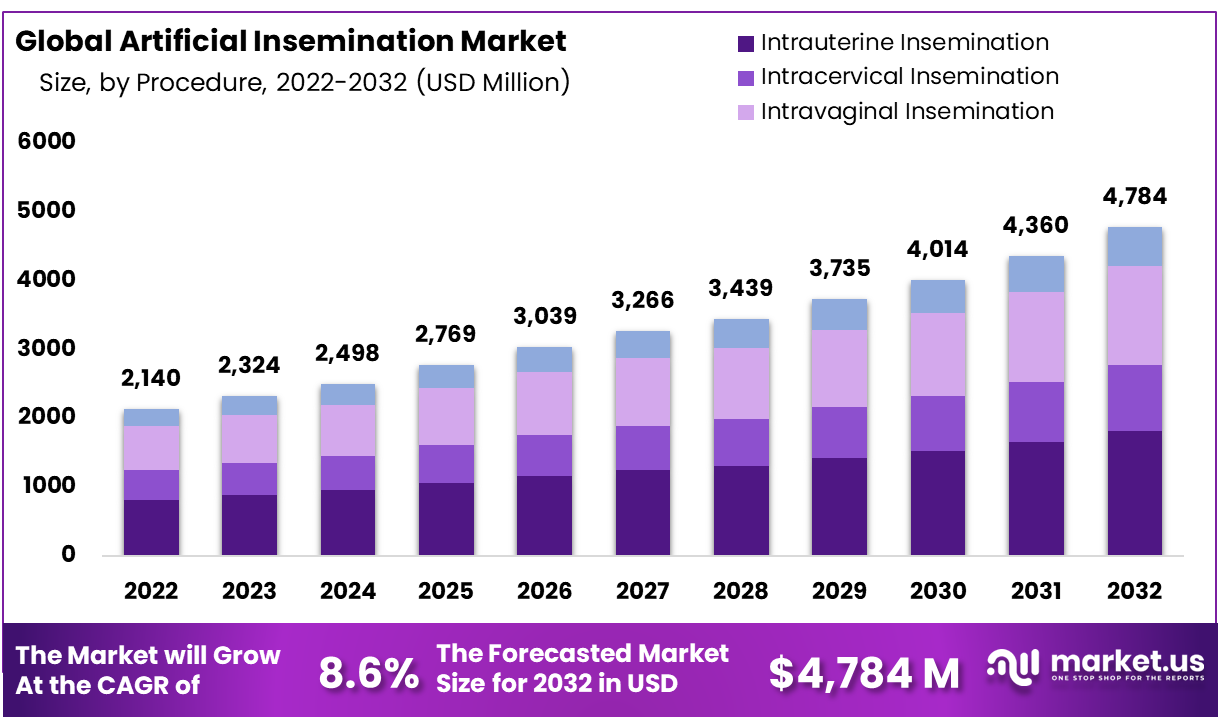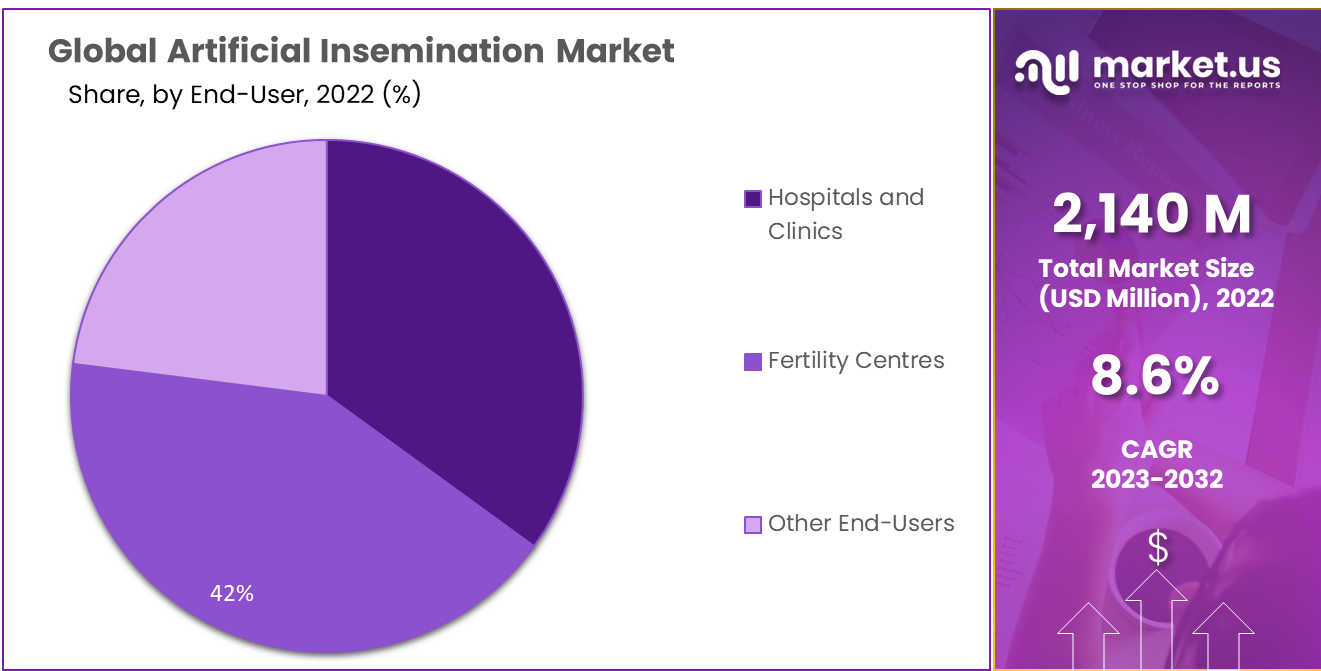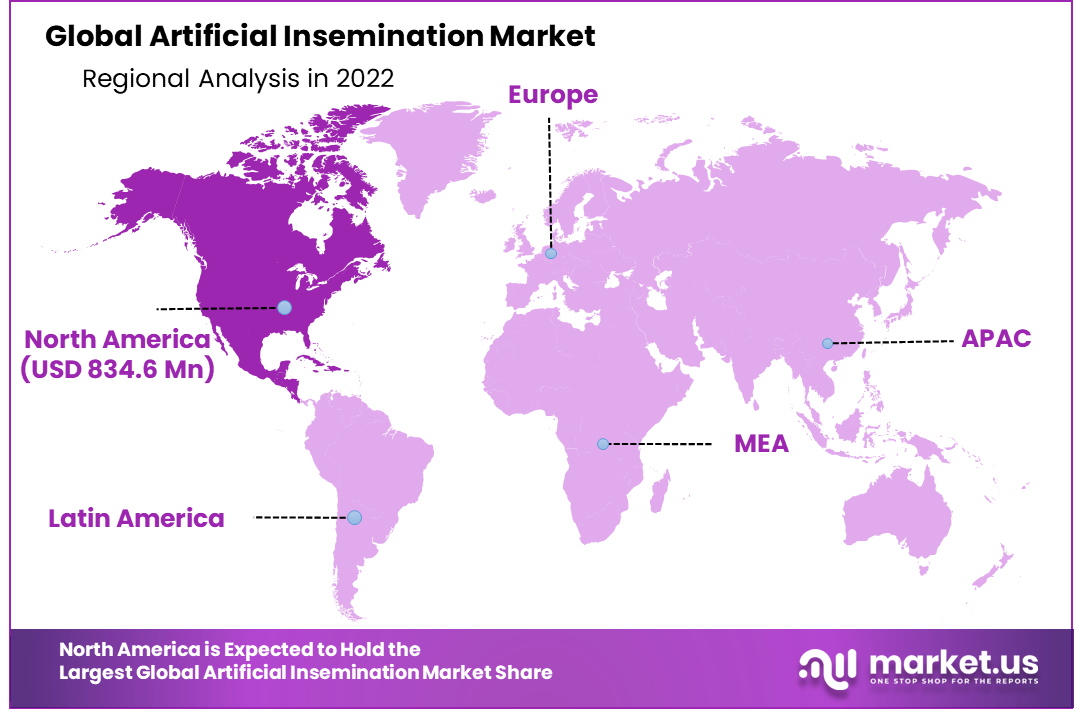Global Artificial Insemination Market By Procedure (Intrauterine Insemination, Intracervical Insemination, Intravaginal Insemination, and Intratubal Insemination), By Source Type (AIH-Husband and AID-Donor), By End-User, By Region and Companies - Industry Segment Outlook, Market Assessment, Competition Scenario, Trends and Forecast 2023-2032
- Published date: Oct 2023
- Report ID: 58298
- Number of Pages: 240
- Format:
- keyboard_arrow_up
Quick Navigation
Report Overview
According to a recent report by Market.us, the Global Artificial Insemination Market size is expected to be worth around USD 4,784 Million by 2032 from USD 2,140 Million in 2022, growing at a CAGR of 8.6 % during the forecast period from 2023 to 2032.
Artificial insemination encompasses various assisted reproductive techniques, including Artificial Insemination Recipient Semen (AID) and Artificial Fertilization Homologous (AIH). These procedures involve the injection of live sperm-containing semen into a woman’s cervix, uterus, or fallopian tubes. There are two primary options: Artificial Insemination with Recipient Semen (AID) and painless Artificial Fertilization Homologous treatments (AIH). Notably, self-insemination kits, designed for in-home use, have become available in the market, offering a convenient approach to these procedures.
There has been a notable increase in public awareness surrounding a variety of reproductive techniques, particularly those related to assisted reproduction. Media outlets now frequently feature discussions on assisted reproduction technologies, including artificial insemination. The visibility and accessibility of these procedures have expanded due to the growing number of infertility clinics and hospitals across the country. Support from governments in certain nations, as well as the incorporation of fertility treatment coverage into insurance policies in others, will contribute to the growth of this market, particularly benefiting same-sex couples.
Additionally, women who are fully engaged in their careers may postpone starting families due to financial responsibilities. For couples facing fertility challenges, assisted reproductive treatments such as artificial insemination provide a ray of hope.

*Actual Numbers Might Vary In The Final Report
Key Takeaways
- The global Artificial Insemination Market is growing at a CAGR of 8.6% from 2023 to 2032.
- Infertility affects about 17.5% of the adult population globally, approximately 1 in 6 adults.
- Intrauterine Insemination (IUI) is the dominant procedure, maintaining the largest market share among various assisted reproductive techniques.
- Artificial Insemination of the Husband (AIH) is expected to hold the largest market share among source types.
- Fertility clinics accounted for the largest revenue share among end-users in 2022.
- Innovative technologies are enhancing artificial insemination procedures, leading to more personalized and effective treatments.
- Fertility tourism is on the rise, with patients seeking advanced and cost-effective artificial insemination services internationally.
- Miniaturization of devices is a trend in the market, making treatments less invasive and more convenient.
- At-home insemination kits are gaining popularity, offering privacy and convenience to patients.
- North America dominated the global Artificial Insemination market, with a revenue share of 39% in 2022.
Driving Factors
Increasing Prevalence of Infertility to surge the market growth
The rising prevalence of infertility worldwide serves as a robust driver for the artificial insemination market. This increase in infertility cases can be attributed to a multitude of factors, including lifestyle changes characterized by stress, sedentary routines, and unhealthy diets. Additionally, delayed pregnancies, driven by factors like career pursuits and economic considerations, have become more common. Environmental factors, such as exposure to pollutants, also contribute to fertility challenges. Consequently, an increasing number of couples are turning to assisted reproductive technologies like artificial insemination to fulfill their dream of parenthood.
- According to WHO, the issue of infertility affects approximately 17.5% of the adult population globally, which equates to about 1 in 6 adults facing difficulties in conceiving. The data indicates that this is a pressing global health concern requiring greater accessibility to affordable and high-quality fertility treatment. Interestingly, the prevalence rates are fairly consistent across countries with varying income levels; high-income countries have a lifetime prevalence rate of 17.8%, while the rate for low- and middle-income countries is 16.5%. This suggests that infertility is a widespread challenge that transcends economic boundaries.
Expanding Healthcare Infrastructure drives market growth
The proliferation of healthcare facilities, particularly fertility clinics and specialized centers, is significantly expanding access to artificial insemination services. Improved healthcare infrastructure ensures that patients can avail of these treatments conveniently. The strategic placement of these clinics, often in urban and suburban areas, enhances accessibility. As a result, individuals and couples facing fertility challenges have easier access to the expertise and advanced technologies offered by these facilities, further fuelling the growth of the artificial insemination market.
Restraining Factors
High Treatment Costs as well as Ethical and Cultural Factors to impede the market growth
The cost associated with artificial insemination can be substantial, limiting access for many couples, especially in regions with limited insurance coverage. High expenses for multiple treatment cycles can deter some individuals from pursuing artificial insemination. Ethical concerns and cultural norms related to artificial insemination vary widely across different regions and communities. These factors can lead to resistance and lower adoption rates in specific cultural contexts.
Procedure Analysis
Intrauterine Insemination is estimated to dominate the market during the forecast period
On the basis of procedure, the market is divided into intravaginal insemination, intracervical insemination, intrauterine insemination, and intratubal insemination. Among these procedures, in 2022, intrauterine insemination (IUI) is poised to maintain its position as the dominant segment, commanding the largest market share among various assisted reproductive techniques. This trend of segmental development is expected to persist, featuring the enduring effectiveness and widespread adoption of intrauterine insemination. One key advantage of IUI is its non-surgical nature, making it a preferred choice for many.
Furthermore, the IUI segment is anticipated to witness substantial growth in the coming years, driven by increasing fertility rates, the adoption of improved IUI process technologies, and greater public awareness of assisted reproductive technologies. Meanwhile, the intravaginal segment for artificial fertilization is projected to steadily expand and is expected to rank second globally. Intravaginal insemination (IVI) procedures can be conducted either at home or within fertility clinics, serving various purposes, including surrogacy and donor insemination. This versatility is contributing to the growing adoption of IVI in the assisted reproduction landscape.
Source Type Analysis
AIH-Husband is anticipated to hold the largest market share in upcoming years
Based on source type, the global artificial insemination market is AIH-Husband and AID-Donor. Among these segments, Artificial Insemination of the Husband (AIH) is forecasted to maintain its dominance in the global industry with the highest Compound Annual Growth Rate (CAGR) throughout the projected period. AIH is a procedure that enables couples to establish biological connections without relying on sperm donors, as it involves the husband collecting semen for artificial insemination.
This method has witnessed rapid growth, attributed to technological advancements in artificial insemination techniques and evolving regulations and consumer preferences. AIH continues to be a preferred choice, emphasizing the significance of maintaining a biological link within the family unit.
End-User Analysis
Fertility Centers accounted for the largest revenue share in 2022
Based on end-user, the market is categorized into hospitals and clinics, fertility centres, and other end-users. Among these end-users, the fertility clinics held the largest market share in 2022. It is also expected to grow at the fastest CAGR during the forecast period. Fertility clinics, in particular, have been proactive in raising awareness among clients about the array of treatments available for infertility issues, driven by the increasing global incidence of infertility cases. These factors are set to sustain the market’s growth momentum over the projected period, as they continue to cater to the growing demand for assisted reproductive solutions.

Key Market Segments
By Procedure
- Intrauterine Insemination
- Intracervical Insemination
- Intravaginal Insemination
- Intratubal Insemination
By Source Type
- AIH-Husband
- AID-Donor
By End-User
- Hospitals and Clinics
- Fertility Centres
- Other End-Users
Growth Opportunity
Innovative Technologies to offer numerous growth opportunities
The integration of innovative technologies is revolutionizing artificial insemination procedures and creating opportunities for more personalized and effective treatments. Genetic screening allows for the identification of potential genetic disorders, enabling healthcare providers to offer tailored solutions. Precision medicine approaches analyze individual patient profiles to determine the most suitable treatment regimens. Additionally, telemedicine is making healthcare consultations more accessible, enabling remote monitoring and support for patients undergoing artificial insemination. These technological advancements are enhancing the precision and success rates of treatments, attracting more patients to the artificial insemination market.
Fertility Tourism
Medical tourism related to fertility treatments is gaining momentum. Patients are increasingly willing to travel to countries that offer advanced and cost-effective artificial insemination services. This trend is fueled by a desire for high-quality care at competitive prices. Destination countries with well-established fertility clinics and a reputation for successful outcomes are experiencing a surge in fertility-related tourism. The revenue potential of the artificial insemination market is bolstered by the influx of international patients seeking these services.
- Fertility tourism is on the rise in response to increasing rates of infertility worldwide. According to the World Health Organization, around 49 million couples and 186 million individuals globally are affected by infertility. Moreover, global fertility rates have halved since 1950, as reported by the University of Washington’s Institute for Health Metrics and Evaluation. This decline in fertility is so significant that 23 countries, including Portugal, Thailand, Spain, and South Korea, are expected to see their populations decrease by more than half by the end of the century.
Latest Trends
Miniaturization of Devices
A prominent trend in the artificial insemination market is the development of smaller and more portable devices for procedures. This miniaturization of equipment offers several advantages. It makes treatments less invasive, reducing discomfort for patients. Additionally, smaller devices are more convenient to handle, providing healthcare providers with greater precision during procedures. Patients benefit from increased comfort and decreased recovery times, which can lead to higher patient satisfaction and improved treatment outcomes.
At-Home Insemination Kits
The availability and popularity of at-home insemination kits are on the rise. These kits cater to changing consumer preferences for privacy and convenience. They empower individuals or couples seeking insemination treatments to perform certain steps in the comfort of their homes. At-home insemination kits come with clear instructions and the necessary tools, making the process more accessible and manageable. This trend reflects the evolving landscape of fertility care, where patients are given more options to choose the setting that suits their needs best.
Regional Analysis
North America dominated the global Artificial Insemination market with revenue share of 39%
Based on region, the global Artificial Insemination market is divided into North America, Western Europe, Eastern Europe, Asia Pacific, Latin America, and Middle East & Africa. Among these regions, North America accounted for the highest revenue share of 39% in 2022. This significant share is gained due to advanced technology and government support for fertility insurance in this region. In addition, the growth of this region can be attributed to the ART and infertility treatments such as artificial insemination.
Moreover, the European market has demonstrated significant revenue growth, primarily driven by the rising challenges faced by couples in achieving reproduction. Data from the European Society for Human Reproduction and Embryology highlights that by 2025, a staggering 25 million European couples will grapple with infertility issues. This expansion of the European artificial insemination market can be attributed to the increasing demand for assisted reproductive technologies and minimally invasive fertility treatments. To cater to the burgeoning need for artificial fertilization services, key players in this sector are making substantial investments in research and development (R&D) efforts.

Key Regions and Countries
- North America
- The US
- Canada
- Mexico
- Western Europe
- Germany
- France
- The UK
- Spain
- Italy
- Portugal
- Ireland
- Austria
- Switzerland
- Benelux
- Nordic
- Rest of Western Europe
- Eastern Europe
- Russia
- Poland
- The Czech Republic
- Greece
- Rest of Eastern Europe
- APAC
- China
- Japan
- South Korea
- India
- Australia & New Zealand
- Indonesia
- Malaysia
- Philippines
- Singapore
- Thailand
- Vietnam
- Rest of APAC
- Latin America
- Brazil
- Colombia
- Chile
- Argentina
- Costa Rica
- Rest of Latin America
- Middle East & Africa
- Algeria
- Egypt
- Israel
- Kuwait
- Nigeria
- Saudi Arabia
- South Africa
- Turkey
- United Arab Emirates
- Rest of MEA
Key Players Analysis
The artificial insemination market exhibits a fragmented landscape, characterized by the presence of numerous local and regional players. These market participants face rigorous competition, particularly from prominent players known for their robust brand reputation and extensive distribution networks. In order to maintain a competitive edge within the market, companies have adopted a range of expansion strategies, including forging partnerships and introducing new products.
These strategic initiatives are instrumental in enabling companies to not only survive but also thrive in a highly competitive environment, ensuring they remain at the forefront of the artificial insemination market.
Top Key Players
- Conceivex, Inc.
- Pride Angel
- FUJIFILM Irvine Scientific
- High-Tech Solutions
- Rinovum Women’s Health, LLC
- TenderNeeds Fertility
- Biogenics Inc.
- LABOTECT GMBH
- Hamilton Thorne, Inc.
- Nikon Instruments Inc.
- Other Key Players
Recent Developments
- In April 2023, TOWAKO REPRO BIO CELL INC. partnered with Marubeni Corporation to invest in the Philippines’ IVF sector. They joined forces through an investment in Conceive IVF Manila Inc., a company that operates an IVF diagnostic center.
- In February 2023, China’s National Healthcare Security Administration made an announcement regarding the inclusion of assisted reproductive technology costs in medical insurance. This move is anticipated to promote the use of artificial insemination in China.
Report Scope
Report Features Description Market Value (2022) USD 2,140 Mn Forecast Revenue (2032) USD 4,784 Mn CAGR (2023-2032) 8.6% Base Year for Estimation 2022 Historic Period 2016-2021 Forecast Period 2023-2032 Report Coverage Revenue Forecast, Market Dynamics, Competitive Landscape, Recent Developments Segments Covered By Procedure – Intrauterine Insemination, Intracervical Insemination, Intravaginal Insemination, and Intratubal Insemination; By Source Type – AIH-Husband and AID-Donor; By End-User Regional Analysis North America – The US, Canada, & Mexico; Western Europe – Germany, France, The UK, Spain, Italy, Portugal, Ireland, Austria, Switzerland, Benelux, Nordic, & Rest of Western Europe; Eastern Europe – Russia, Poland, The Czech Republic, Greece, & Rest of Eastern Europe; APAC – China, Japan, South Korea, India, Australia & New Zealand, Indonesia, Malaysia, Philippines, Singapore, Thailand, Vietnam, & Rest of APAC; Latin America – Brazil, Colombia, Chile, Argentina, Costa Rica, & Rest of Latin America; Middle East & Africa – Algeria, Egypt, Israel, Kuwait, Nigeria, Saudi Arabia, South Africa, Turkey, United Arab Emirates, & Rest of MEA Competitive Landscape Conceivex, Inc., Pride Angel, FUJIFILM Irvine Scientific, High-Tech Solutions, Rinovum Women’s Health, LLC, TenderNeeds Fertility, Biogenics Inc., LABOTECT GMBH, Hamilton Thorne, Inc., Nikon Instruments Inc. and Other Key Players. Customization Scope Customization for segments, region/country-level will be provided. Moreover, additional customization can be done based on the requirements. Purchase Options We have three license to opt for: Single User License, Multi-User License (Up to 5 Users), Corporate Use License (Unlimited User and Printable PDF) Frequently Asked Questions (FAQ)
What is Artificial Insemination ?Artificial Insemination (AI) is a reproductive technique that involves introducing sperm into a female's reproductive tract without natural mating. It's commonly used in both humans and animals.
How big is the Artificial Insemination Market?The global Artificial Insemination Market size was estimated at USD 2,140 billion in 2022 and is expected to reach USD 4,784 billion in 2032.
What is the Artificial Insemination Market growth?The global Artificial Insemination Market is expected to grow at a compound annual growth rate of 8.6%. From 2023 To 2032
Who are the key companies/players in the Artificial Insemination Market?Some of the key players in the Artificial Insemination Markets are Conceivex, Inc., Pride Angel, FUJIFILM Irvine Scientific, High-Tech Solutions, Rinovum Women's Health, LLC, TenderNeeds Fertility, Biogenics Inc., LABOTECT GMBH, Hamilton Thorne, Inc., Nikon Instruments Inc., Other Key Players
Why is AI used in the market?AI is used to improve breeding outcomes in livestock, enhance fertility treatments in humans, and assist in genetic selection, ultimately leading to better reproductive success.
What are the key benefits of Artificial Insemination in the market?AI offers advantages such as controlled breeding, increased genetic diversity, disease control, and the ability to preserve valuable genetic traits.
 Artificial Insemination MarketPublished date: Oct 2023add_shopping_cartBuy Now get_appDownload Sample
Artificial Insemination MarketPublished date: Oct 2023add_shopping_cartBuy Now get_appDownload Sample - Conceivex, Inc.
- Pride Angel
- FUJIFILM Irvine Scientific
- High-Tech Solutions
- Rinovum Women's Health, LLC
- TenderNeeds Fertility
- Biogenics Inc.
- LABOTECT GMBH
- Hamilton Thorne, Inc.
- Nikon Instruments Inc.
- Other Key Players
- settingsSettings
Our Clients
| Single User $4,599 $3,499 USD / per unit save 24% | Multi User $5,999 $4,299 USD / per unit save 28% | Corporate User $7,299 $4,999 USD / per unit save 32% | |
|---|---|---|---|
| e-Access | |||
| Report Library Access | |||
| Data Set (Excel) | |||
| Company Profile Library Access | |||
| Interactive Dashboard | |||
| Free Custumization | No | up to 10 hrs work | up to 30 hrs work |
| Accessibility | 1 User | 2-5 User | Unlimited |
| Analyst Support | up to 20 hrs | up to 40 hrs | up to 50 hrs |
| Benefit | Up to 20% off on next purchase | Up to 25% off on next purchase | Up to 30% off on next purchase |
| Buy Now ($ 3,499) | Buy Now ($ 4,299) | Buy Now ($ 4,999) |












